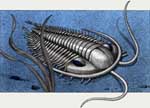 | 

The Evidence From the Fossil Record
The "Cambrian Explosion" | Evolutionists regard pre-Cambrian rock to be the lowest level of sedimentary rock; however, few types of fossils are found there. The "lowest" level of abundant fossilization is in the Cambrian rock layer. Evolutionists claim that was formed over a period of time from 600 - 520 million years ago. | 
  Does the Geologic Column Prove Evolution? Does the Geologic Column Prove Evolution?
 Supplemental Reading Supplemental Reading

Cambrian rock contains many examples of complex, fully formed invertebrates including trilobites, sponges, brachiopods, worms, jellyfish, sea urchins, sea cucumbers, and crinoids. Many of these animals have complex organs. The trilobite, which has an extremely complex eye, was the "first" animal to leave abundant fossil remains.

|  Microgeometric Design of Diatoms: Jewels of the Sea Microgeometric Design of Diatoms: Jewels of the Sea
 Supplemental Reading Supplemental Reading
|

Lack of transitional forms | 1. There is not one example of a transitional animal that developed into the trilobite. | 
2. Fossils of bacteria and algae have been found in the pre-Cambrian rock, but there are no examples of intermediate life forms between single-cell and multi-celled creatures. | 
3. There are no transitional forms which show how invertebrates evolved into fish. | 
4. There are no transitional forms to show how fish evolved into amphibians. | 
 Did Lungfish Evolve Into Amphibians? Did Lungfish Evolve Into Amphibians?
 Supplemental Reading Supplemental Reading
| 
5.There are no transitional forms to show how amphibians evolved into reptiles. | 
6.There are no transitional forms to show how reptiles evolved into birds. | 
7.There are no transitional forms to show how reptiles evolved into mammals. | 
 Mammal-like reptiles Mammal-like reptiles

| 
(This topic will be discussed in more detail in the module entitled: Evolution: Challenge of the Fossil Record.) |
Living Fossils
| 1. We can "use the same criteria to classify both living plants and animals and those found as fossils." (Morris, H. and Parker p.129) | 
2. There are many examples of fossil animals that are found identical to the ones that are alive today:
 a. beetles a. beetles
 b. dragonflies b. dragonflies
 c. cockroaches c. cockroaches
 d. horse shoe crabs d. horse shoe crabs
 e. coelacanth e. coelacanth
|
Mosaics
| 1. In the fossil record we see many examples of animals which represent a mosiac i.e., a unique combination of non-unique characteristics. | 
2. The Archaeopteryx is an example of a mosaic:  | a. | it has common bird traits: beak, wings, feathers, furcula |  | b. | it has traits uncommon for a bird: teeth in the bill, claws on the wings, no breastbone with a keel, unfused backbone, long, bony tail
| | 
3. The uncommon traits are not unique:
 a. other fossil birds have teeth in their beak a. other fossil birds have teeth in their beak
 b. the ostrich has claws on its wings b. the ostrich has claws on its wings
 c. several birds (hoatzin, for example) don’t have a usual keel c. several birds (hoatzin, for example) don’t have a usual keel
 d. Penguins have bony tails d. Penguins have bony tails
|
Objections to some commonly used evolutionary fossil examples

|

